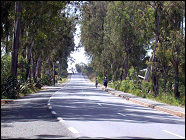 BACKGROUND
TO THE ESTABLISHMENT THE FUND BACKGROUND
TO THE ESTABLISHMENT THE FUND |
Geographical details
· Land Area of 26,338 km2
· A population of 8 million
· GNP/person = US$ 230
· Altitude ranges between 800m and 4000 above
sea level with a country average of 1700m
· 1700km from Mombasa Port in Kenya
· 1600 km from Dar-es-Salaam Port in Tanzania

The National Road Network
Rwanda currently has a road network of some 14,000
km distributed as follows:
Km
· Bitumen treated surface 1,032
· Gravel treated surface 4,386
· Earth surface 8,592
Road
classes and pavement types in km Table
Rwanda has 0.54km/km2 as its Road Network Density,
one of the highest in Africa
Selected
Road condition survey (2001) Table
Daily
Traffic count on some selected roads (8th - 15th
April 2001); DTC = Daily Traffic count
Financial
Highlights (1995 - 2001) Table
Comparative
Revenue and Expenditure (1995 - 2001) Table
· Expenditure of the FER Secretariat and
the Board was 5.5% of 2001 revenue in its first
year of operation. This is expected to gradually
reduce to 3% as capital expenditure reduces over
time.
 MISSION MISSION
|
The mission of the Road Maintenance Fund is to
ensure that Rwanda, through sustainable maintenance,
has a smooth, economical, efficient, safe and
reliable trunk road nework linking regional and
district capitals and other towns within the country
and to major towns in the neighbouring countries.

The network also forms the main routes for internal
distribution, export and import in harmony with
other modes of transportation. It is part of the
RMF's broad vision that a well maintained road
network would facilite socio-economic development
in the country by providing a viable transfer
of goods and people both within and outside the
country.
 OBJECTIVES OBJECTIVES |
· To involve road users in the management
of roads in order to win public support for more
road funding, thereby controling potential monopoly
power and constraining road maintenance spending
to what is affordable.
· To secure an adequate and stable source
of funds and introduce secure arrangements for
channelling these into prioritised road maintenance
programs.
· To strengthen maintenance management
systems by providing effective systems and procedures
for managerial accountability.
· To ensure that road maintenance financing
is managed like a business and not like a bureaucracy.
· To promote private sector initiatives
in the road maintenance financing and works execution.
 |
 STRATEGY STRATEGY
|
· Commercialisation of Road Maintenance Fund
by bringing roads to be maintained into the market
place and put them on a fee-for-service basis. RMF
would become a purchaser of services from service
providers.
· Strengthening the capacity and capability
of road maintenance contractors at the commune level
through occasional professional training programs.
· Promote structures that would encourage
technical and financial audit of road maintenance
programs so that the Fund's revenues produce value
for money.
· Institute an efficient revenue collection
system that would keep to a minimum avoidance, evasion
and leakage
· To win support of tax payers by ensuring
that the proceeds are spent exclusively on road
maintenance works, that works are done efficiently,
and that the Fund is free from political interference
· Promote labour-based maintenance work methods
at commune level in line with the Government's poverty
eradication policy
 OBJECTIVE
ACHIEVEMENT OBJECTIVE
ACHIEVEMENT |
What is the Expected End Result?
A dedicated financing arrangement that ensures a
sustainable and stable basis for road maintenance.
This will ultimately translate to improved service
delivery and operational efficiency.
 KEY
PERFORMANCE INDICATORS KEY
PERFORMANCE INDICATORS |
- Quality of road network (road quality improvement)
- Operational efficiency (improved contract management
and disbursement arrangements)
- Allocative efficiency (commercial orientation
and strong constituency to determine resource allocation)
Allocation to be determined by a planned review
of programs rather than by a standard allocation
formula
- Development of local construction industry (efficiency
gains in resource use to be achieved by improvements
in works programming and contracting out)
 WHAT
HAS BEEN ACHIVED SO FAR WHAT
HAS BEEN ACHIVED SO FAR |
Establishment of Road Maintenance Fund with legal
framework provision (Nov 1998)
· Road Maintenance Management Board (April
1999)
· Road Maintenance Management Secretariat
( December 2000)
· Resource allocation and annual budget adoption
by Board and the Cabinet.
· Annual maintenance works programs by the
Directorate of Roads and by Kigali City Council
· Revenue collection monitoring. Collection
mandated/subcontracted to Rwanda Revenue Authority
from October 2001
· Separation between financing and executing
functions
· Gradual phasing out of Force Account work
method (replaced by contracts with Communes)
 KEY
LESSONS LEARNT SO FAR KEY
LESSONS LEARNT SO FAR |
· Transparency and accountability in the
use of maintenance fund gradually showing
· Amounts of collected revenues are still
short of total maintenance requirements ( only 25
% of requirements met annually)
· There exists a huge maintenance works backlog
that will take many years to clear
· A substantial portion of the road network
is beyond maintenance ® needs rehabilitation
or reconstruction
· There is a clear lack of local capacity
in road maintenance (planning, programming and execution)
· Lack of fully functional road maintenance
management system
 AND
THE WAY FORWARD AND
THE WAY FORWARD |
· Put in place a comprehensive Procedure
Manual
· To establish a more firm legal framework
to support the existing law through the Internal
Regulation
· Improve internal organisation in order
for the Fund to be managed on sound commercial principles
· Increase financial resources by :
- Revising current rates & tariffs
- Consider grants and loans for periodic maintenance
· Training of Secretariat staff towards improved
managerial and operational efficiency
· Establish Monitoring and Evaluation system. |

